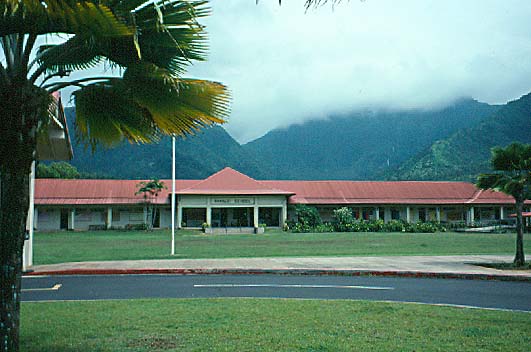 |
 |
 |
|||||||||
|
|
|
|
|
|
|
|
|
||||
|
|
|||||||||||
|
|||||||||||
|
The new school at Hanalei serves children of the Halele‘a district.
|
The Hui Maka‘ainana o Makana was formed in 1998 by key members of the native community in Ha‘ena who had been discussing how to restore Hawaiian values and stewardship practices for some years. They began the formal process of organizing into a group that could obtain IRS 501(c)(3) (federally recognized non-profit) status. This official status was necessary in order to develop a relationship with the State Park system, who controls a large portion of the ahupua‘a. As they proceeded, these people realized the need to be very clear and focused in their mission. After meeting for several months, they ultimately adopted the following mission statement:
Carlos explains that in dealing with State Parks, which is a branch of the State government, it is important to have some sort of formal recognition. "The State Parks and government bureaucracies are very leery of dealing with communities, because communities are messy--not blocked off with job descriptions and officers and structure they can deal with. And besides, we have Hawaiian members who are sovereignty activists, so they're all very leery about that. "'Community' is a very nebulous term. It's a group of people. But to establish ourselves as a 501(c)3 organization recognized by the federal government, we had to create a structure in which we have a board of directors, and what we call an ‘Ohana Council. Hopefully the decision-making and the sort of tone, the voting part of the organization, will remain with the people who are native to this place. They might be on O‘ahu, or the other side of this island, but as long as they have roots in this place."
|
||
|
|
||
This Community has a two-tiered organizational structure. There is a general membership, open to the public, and a governing council--The ‘Ohana Council--that controls decision-making authority: Membership: "Any member of the world can be a member of our organization, but theirs is a general membership--they can participate in our programs, or we can hire them to work for us, or give money to us, or come to our workdays, or any kind of functions that we have, but they have no voting power. Because what we have seen happen in Hawai‘i is that, you get a group of people with a little organization, and a whole bunch of people move here from the continent, and they all join, and they out-vote all the native people there, and the native people no longer have a voice, so we wanted to at least put some kind of a check in there against that kind of thing happening. Government: "The ‘Ohana Council really has all the power in the Hui Maka‘ainana o Makana. They can elect or depose any member of the board of directors any time they wish. And they decide who is acceptable as a member of the ‘Ohana Council and who is not. And eligibility for the ‘Ohana Council is that your family has had to have had some connection with Ha‘ena ahupua‘a prior to 1955, which is where the division of all the lands in Ha‘ena began. So prior to that it was held in common by the Hui Ku‘ai ‘Aina. And all of these family members were members of the Hui Ku‘ai ‘Aina, or who have lived in Ha‘ena prior to 1955. As long as they have roots in this place; we have people who live on the other side of the island whose family is from this area, they are members of our ‘Ohana. So in a way, it preserves the integrity of the group. This is one definition of the community--these are the only people who have voting power. "However, there is a clause in there that says that if the ‘Ohana Council wants to invite a person who is not connected with Ha‘ena prior to 1955, they can vote him in, but also they can limit his membership--for a year, or until we say "no," that kind of thing. At the same time, since anyone in the world can join, it is a very broad community, but like to keep the decision-making with the people that live here."
|
||
|
|
||
Stewardship of the land, restoring the idea of the ahupua‘a in spirit if not in practice, is a primary purpose of the Hui Maka‘ainana o Makana. And moreover, to do so using a community of persons connected with the original Hui Ku‘ai ‘Aina. Rejuvenating the use of the lowland taro lo‘i in the area now controlled by the State Parks would provide an important basis of this new approach, and would help also to finance the needs of the Hui. "We would have people in our community that would work through the 501(c) 3, and be the stewards of certain of these lo‘i. And a percentage of what they raise would go to the organization, and a percentage they would keep. It would be an activity of the non-profit organization to re-invest much of the money. Because, like non-profits anywhere, they would have to generate income in order to pay their staff members, in order to pay the people who work for them. So we'll need people who understand business, we'll need people who know how to grow taro, people who know how to fix engines, whatever, you name it." Limahuli Gardens has provided a document with information on the Hui Maka‘ainana o Makana. You can download it here (Rich Text format). Continue to learn about the restoration of the replanting of the lo‘i complex.
|
||
|
|
||
| |
| |
|
|
 |
| Ha'ena Home | Map Library | Site Map | Hawaiian Islands Home | Pacific Worlds Home |

|
|||
| Copyright 2001 Pacific Worlds & Associates • Usage Policy • Webmaster |
|||




